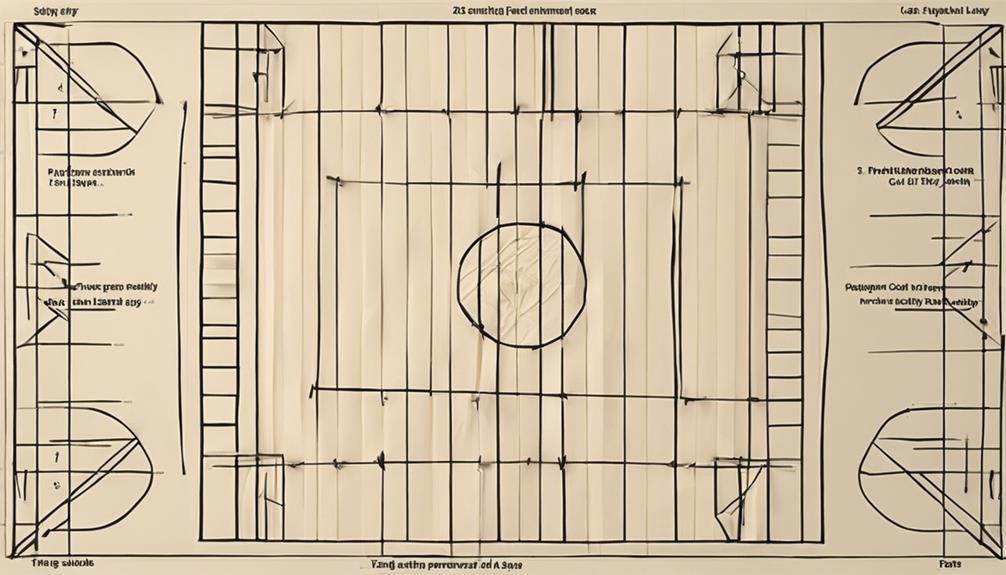General Rules of Shinty Sport
In the realm of Shinty, where sticks clash and players dance with the ball in a symphony of skill and strategy, understanding the general rules is key to mastering the sport. From the dimensions of the field to the nuances of fouls and offside calls, each aspect contributes to the intricate tapestry of this ancient game. But what truly sets Shinty apart lies in the blend of tradition and athleticism, a unique combination that keeps players and spectators alike captivated.
Field Dimensions and Layout

When setting up a game of Shinty, it's crucial to ensure the field dimensions and layout adhere to the official regulations to guarantee fair play. Understanding the field boundaries is fundamental in preventing any misunderstandings during the game. The field should be rectangular, with clearly marked sidelines and goal lines. Properly defining these boundaries not only aids the players in staying within the limits but also helps the officials in making accurate calls.
Strategic positioning plays a pivotal role in the success of a team during a Shinty match. Players need to be mindful of their placement on the field to maximize their impact. Forwards should position themselves closer to the opponent's goal, ready to receive passes and take shots. Midfielders act as the link between defense and offense, requiring them to have a strong presence in the center of the field. Defenders must hold their positions near their own goal, ready to thwart any incoming attacks.
Additionally, understanding the field layout allows players to anticipate the flow of the game better. By strategically positioning themselves based on the field dimensions, players can create passing lanes, cover defensive gaps, and exploit weaknesses in the opponent's formation. Mastering the art of strategic positioning can give a team a significant advantage on the field.
Team Composition and Positions
Understanding the strategic positioning on the field in Shinty is crucial for optimizing team composition and player positions for maximum effectiveness during the game. Player rotations and strategic substitutions play a significant role in maintaining a fresh and dynamic team. In Shinty, teams typically consist of 12 players, with each player having a specific role and position on the field.
Defensive formations in Shinty are vital for protecting the goal and preventing the opposing team from scoring. Players are strategically positioned to block shots, intercept passes, and clear the ball out of the danger zone. Common defensive strategies include man-marking, zonal marking, and pressing the opposition to regain possession quickly.
On the other hand, offensive strategies focus on creating goal-scoring opportunities and breaking through the opponent's defense. Players need to work together to move the ball up the field, maintain possession, and take accurate shots on goal. Strategic positioning during attacks, such as spreading out wide or making runs into open spaces, can create gaps in the opposing team's defense.
Throughout the game, teams may make tactical substitutions to adjust their playing style or provide rest to fatigued players. Understanding the roles of each position and executing effective defensive formations and offensive strategies are key to achieving success in Shinty.
Gameplay and Ball Movement

To excel in Shinty, mastering the dynamics of gameplay and ball movement is essential for players and teams. When it comes to passing techniques, precision is key. Quick, accurate passes can disrupt the opponent's defense and create scoring opportunities. Additionally, understanding defensive strategies is crucial to anticipate the opponent's moves and intercept passes effectively.
In the heat of the game, ball handling plays a significant role. Players need to have excellent control over the ball to maneuver through the field, evade defenders, and set up scoring chances. Moreover, offensive tactics are vital for breaking through the opposing team's defense. Strategic positioning, coordinated attacks, and well-executed plays can lead to successful goal opportunities.
Let's delve deeper into the key aspects of gameplay and ball movement in Shinty:
| Passing Techniques | Defensive Strategies |
|---|---|
| Quick, accurate passes | Anticipating opponent's moves |
| Varied passing angles | Intercepting passes effectively |
| Team communication | Maintaining defensive shape |
| Pressuring opponents | |
| Clearing the ball from danger zones |
Mastering these aspects of gameplay and ball movement can elevate your performance on the field and contribute to your team's success.
Tackling and Physical Contact
In Shinty, tackling and physical contact are integral components that demand precise execution and strategic maneuvering from players on the field. When it comes to tackling, players must find the delicate balance between using proper technique and avoiding unnecessary aggression. While the sport allows for physicality, it emphasizes skillful maneuvering over brute force. Players are encouraged to focus on mastering techniques such as timing interceptions, making controlled challenges, and executing clean tackles to regain possession or disrupt the opponent's play.
Safety measures play a crucial role in ensuring that the physical aspect of Shinty remains within the boundaries of fair play. Players are required to wear appropriate protective gear, including helmets and shin guards, to minimize the risk of injuries during tackles and physical confrontations. It is essential for players to respect their opponents' well-being and abide by the rules set forth to maintain a safe playing environment.
Understanding the difference between using technique and resorting to aggression is key to excelling in tackling and physical contact in Shinty. By honing their skills and approach to physical play, players can contribute positively to the game while upholding the principles of sportsmanship and fair competition.
Sticks and Equipment Regulations

When it comes to playing Shinty, players must adhere to strict regulations regarding the use of sticks and equipment. Stick design and material are crucial aspects of the game. Shinty sticks, traditionally known as camans, are usually made from wood, often ash or hickory. The design of the stick must conform to specific dimensions to ensure fair play and safety on the field.
In Shinty, equipment safety is paramount. Players need to regularly inspect their sticks for any damages or wear and tear that could compromise their integrity during play. Ensuring that sticks are in good condition not only prevents accidents but also contributes to a level playing field for all participants.
Maintenance of equipment is equally important. Players should store their sticks in a dry place to prevent warping or damage, which could affect their performance during a game. Keeping grips clean and intact is also essential for a secure hold while playing. By taking care of their equipment, players not only enhance their own performance but also prolong the lifespan of their gear.
In Shinty, following regulations on stick design, material, equipment safety, and maintenance is essential for a fair and enjoyable game for all involved.
Offside and Fouls
Navigating the fast-paced game of Shinty involves a keen understanding of the rules surrounding offside and fouls to maintain fair play and sportsmanship on the field. In Shinty, offside interpretation is crucial for players to grasp. An offensive player is considered offside if they are nearer to the opponent's goal line than both the ball and the second-to-last defender when the ball is played to them. Understanding this rule is essential to avoid penalties and maintain the flow of the game.
Fouls in Shinty can have serious consequences, impacting the momentum and outcome of the match. Common fouls include dangerous play, striking an opponent, and obstructing an opponent without playing the ball. Players need to be vigilant and avoid these actions to prevent penalties such as free hits or even cards from the umpires. Consistent fouling can lead to players being sent off, leaving their team at a significant disadvantage.
To excel in Shinty, it's vital to play with integrity and respect for the rules. By adhering to offside regulations and avoiding fouls, you contribute to a fair and enjoyable game for all involved. Remember, the consequences of fouls can be far-reaching, so stay focused and play by the rules to maximize your team's chances of success.
Goalkeeper Rules and Responsibilities

Understanding the rules and responsibilities of a goalkeeper is essential for success in the game of Shinty. As a goalkeeper, your positioning on the field and your saving techniques are crucial in preventing the opposing team from scoring goals. Proper goalkeeper positioning involves being alert and ready to react quickly to incoming shots. By staying near the goal line and being able to move swiftly side to side, you increase your chances of making successful saves.
To give you a clearer idea, here is a breakdown of goalkeeper rules and responsibilities in Shinty:
| Goalkeeper Positioning | Saving Techniques |
|---|---|
| Stay near the goal line | Use your hands or body to block shots |
| Be ready to move quickly | Position yourself based on the opponent's angle |
| Communicate effectively with defenders | Dive when necessary to reach the ball |
| Anticipate opponent's moves | Practice catching and deflecting shots |
Scoring and Game Duration
As a goalkeeper in Shinty, your role is crucial in preventing the opposing team from scoring goals; now let's explore the scoring system and game duration in this dynamic sport. Scoring in Shinty mainly involves getting the ball into the opponent's goal using a variety of techniques such as hitting, flicking, or lofting the ball. Players often employ game strategies like quick passes, strategic positioning, and coordinated attacks to outmaneuver the opposition's defense and create scoring opportunities.
In Shinty, a match is typically divided into two halves, each lasting 45 minutes, with a halftime break in between. Time management is essential in Shinty as the game requires bursts of high-intensity actions interspersed with periods of strategic play. Endurance training plays a crucial role in helping players maintain their performance levels throughout the match. Players need to build stamina and resilience to cope with the physical demands of the game and stay competitive until the final whistle.
Understanding scoring techniques and developing effective game strategies are vital for success in Shinty. By honing these skills and mastering time management through endurance training, players can elevate their performance on the field and contribute significantly to their team's success.
Refereeing and Fair Play

Fair play is fundamental in Shinty matches to ensure a competitive and respectful sporting environment for all players involved. Upholding fair play and sportsmanship is crucial in maintaining the integrity of the game and fostering a positive atmosphere on the field. Referees play a vital role in enforcing the rules and promoting fair play among all participants.
When it comes to refereeing in Shinty, officials are responsible for making impartial decisions, ensuring that the game is played fairly, and penalizing any infractions. It is essential for players to respect the decisions made by the referees and to conduct themselves with integrity throughout the match.
The table below outlines some key aspects of refereeing and fair play in Shinty:
| Key Aspects | Description |
|---|---|
| Impartiality | Referees must remain neutral and make decisions based on the rules of the game. |
| Consistency | Referees should apply the rules consistently throughout the match. |
| Player Respect | Players are expected to respect the decisions of the referees at all times. |
| Fair Play | Promoting fair play and sportsmanship is essential in Shinty. |
| Discipline Enforcement | Referees have the authority to enforce discipline and penalize misconduct. |
Maintaining fair play and sportsmanship not only enhances the overall experience of the game but also instills values of respect and integrity in all players involved.
Frequently Asked Questions
What Are the Rules Regarding Substitutions in Shinty?
When it comes to player substitutions in shinty, it's all about team strategy. Making smart swaps can give your team the edge. Keep an eye on the game and switch players strategically.
Are There Any Specific Rules Regarding Player Conduct and Sportsmanship During a Match?
During a match, player behavior is crucial. Fair play is expected at all times. Remember to uphold sportsmanship by respecting opponents, officials, and the game itself. Your conduct can influence the match's spirit positively.
How Are Disputes or Disagreements Between Players or Teams Typically Resolved During a Game?
When disputes arise in a game, players and teams typically resolve them by appealing to referee decisions. It's crucial to maintain fair play and sportsmanship, ensuring disagreements are settled with respect and adherence to rules.
Are There Any Specific Regulations Regarding Player Attire and Uniforms in Shinty?
When playing Shinty, ensure you follow equipment requirements and uniform guidelines. Remember, sponsorship restrictions and brand endorsements are important. Adhering to these rules promotes fairness and unity among players, enhancing the spirit of the game.
What Are the Procedures for Handling Injuries or Medical Emergencies During a Match?
So, when someone gets hurt in a match, swiftly handle it! Get med help, sub in players if needed. Keep it civil, no drama – sporty vibes only. Stay safe, play fair.






